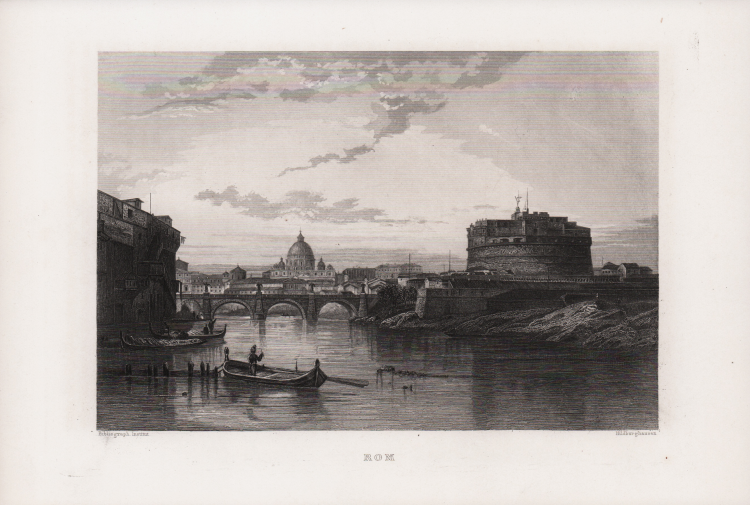



| Reference: | S51400 |
| Author | Carl Joseph MEYER |
| Year: | 1833 |
| Zone: | Ponte e Castel S. Angelo |
| Printed: | Hildburghausen |
| Measures: | 230 x 155 mm |


| Reference: | S51400 |
| Author | Carl Joseph MEYER |
| Year: | 1833 |
| Zone: | Ponte e Castel S. Angelo |
| Printed: | Hildburghausen |
| Measures: | 230 x 155 mm |
Veduta tratta dal celebre Meyer's Universum, raccolta di tavole raffiguranti città e luoghi di tutto il mondo pubblicata in fascicoli a Hildburgshausen, dal Bibliographisches Institut.
Quest'opera seriale molto popolare, lanciata nel 1833 da Carl Joseph Meyer, presentava incisioni di paesaggi, vedute e monumenti architettonici di tutto il mondo. La presentazione di queste immagini evocava un senso di accesso non mediato allo spettacolo visivo, ma si basava su un paradosso. Nei suoi testi Meyer aspirava a offrire ai lettori una visione inedita e di prima mano del mondo conosciuto. Allo stesso tempo, però, la sua strategia editoriale si basava su un sistema di riciclaggio transnazionale e di prestito non riconosciuto di illustrazioni da altre fonti. Lo studio Meyer ripubblicava spesso le immagini in nuove configurazioni in diverse serie, anche in versioni tradotte all'estero. Il risultato privilegiava una presentazione visiva del mondo arbitraria e decontestualizzata, nell'interesse della convenienza editoriale e dell'economicità.
Carl Joseph Meyer nacque a Gotha, in Germania, e si formò come mercante a Francoforte sul Meno. Meyer operò con grande successo come editore, utilizzando un sistema di abbonamento seriale alle pubblicazioni, nuovo per l'epoca. A questo scopo fondò una società, il Bibliographisches Institut, a Gotha nel 1826. Pubblicò diverse edizioni della Bibbia, opere di letteratura classica, il mondo in immagini su incisioni in acciaio ("Meyers Universum", 1833-61, 17 volumi in 12 lingue con 80.000 abbonati in tutta Europa) e un'enciclopedia ("Das Grosse Conversations-Lexikon für die gebildeten Stände"; cfr. Meyers Konversations-Lexikon, 1839-55, 52 volumi). La sua azienda crebbe notevolmente e nel 1828 la trasferì da Gotha a Hildburghausen. Si dedicò alla cartografia, producendo molti atlanti con mappe incise su lastre d'acciaio, tra cui il Meyer Groẞer Hand-Atlas (1843-1860). Dopo la morte di Meyer nel 1856, il figlio Herrmann Julius Meyer rilevò il Bibliographisches Institut, che all'epoca era in difficoltà finanziarie.
Incisione in rame, in buono stato di conservazione.
Carl Joseph MEYER (Gotha, 1796 – Hildburghausen, 1856)
|
Carl Joseph Meyer (9 May 1796 - 27 June 1856) was a German industrialist and publisher, most noted for his encyclopaedia, Meyers Konversations-Lexikon.
Meyer was born at Gotha, Germany, and was educated as a merchant in Frankfurt am Main. He went to London in 1816, but returned to Germany in 1820 after business adventures and stock speculations fell through. Here he invested in enterprises such as the textile trade (1820–24). Soon after the first steam-hauled railway had started in December 1835, Meyer started to make business plans to start the first railways. He also bought some concessions for iron mining. In 1845 he founded the Deutsche Eisenbahnschienen-Compagnie auf Actien (German Railway Rail joint stock company). Meyer operated very successfully as a publisher, employing a system of serial subscription to publications, which was new at that time. To this end he founded a company, Bibliographisches Institut, in Gotha in 1826. It published several editions of the Bible, works of classical literature, the world in pictures on steel engravings ("Meyers Universum", 1833–61, 17 volumes in 12 languages with 80,000 subscribers all over Europe), and an encyclopaedia, ("Das Grosse Conversations-Lexikon für die gebildeten Stände"; see Meyers Konversations-Lexikon, 1839–55, 52 volumes). His company grew substantially, and in 1828 he moved it from Gotha to Hildburghausen. He became involved in cartography, producing many atlases with steel-engraved maps printed from steel plates, including Meyer's Groẞer Hand-Atlas (1843-1860). After Meyer's death in 1856, his son Herrmann Julius Meyer took over the Bibliographisches Institut, which was at that time struggling financially.
|
Carl Joseph MEYER (Gotha, 1796 – Hildburghausen, 1856)
|
Carl Joseph Meyer (9 May 1796 - 27 June 1856) was a German industrialist and publisher, most noted for his encyclopaedia, Meyers Konversations-Lexikon.
Meyer was born at Gotha, Germany, and was educated as a merchant in Frankfurt am Main. He went to London in 1816, but returned to Germany in 1820 after business adventures and stock speculations fell through. Here he invested in enterprises such as the textile trade (1820–24). Soon after the first steam-hauled railway had started in December 1835, Meyer started to make business plans to start the first railways. He also bought some concessions for iron mining. In 1845 he founded the Deutsche Eisenbahnschienen-Compagnie auf Actien (German Railway Rail joint stock company). Meyer operated very successfully as a publisher, employing a system of serial subscription to publications, which was new at that time. To this end he founded a company, Bibliographisches Institut, in Gotha in 1826. It published several editions of the Bible, works of classical literature, the world in pictures on steel engravings ("Meyers Universum", 1833–61, 17 volumes in 12 languages with 80,000 subscribers all over Europe), and an encyclopaedia, ("Das Grosse Conversations-Lexikon für die gebildeten Stände"; see Meyers Konversations-Lexikon, 1839–55, 52 volumes). His company grew substantially, and in 1828 he moved it from Gotha to Hildburghausen. He became involved in cartography, producing many atlases with steel-engraved maps printed from steel plates, including Meyer's Groẞer Hand-Atlas (1843-1860). After Meyer's death in 1856, his son Herrmann Julius Meyer took over the Bibliographisches Institut, which was at that time struggling financially.
|